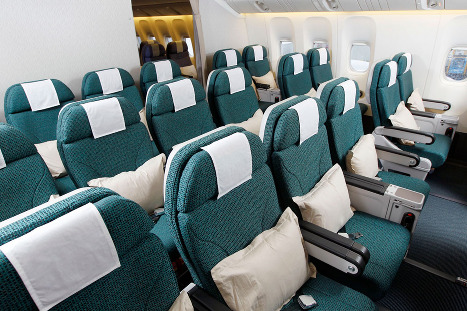Ryanair has a great brand
It sounds counter-intuitive but it’s true. The Ryanair brand is smart, and other airlines have much to learn from it. What is the secret to its astounding success? Read on to find out.
The Ryanair brand is built on a solid foundation and personified by its CEO — with his outrageous comments and cost-cutting proposals. A brand that is reflected in any aspect of the company and that sends users a very clear message:
This is a cheap airline, expect nothing else.
Its customer service is infamous, as are its excess fees, but its balance sheet proves passengers don’t seem to mind. In fact, quite the opposite. Increasingly, passengers who are forced to pay for excess luggage before boarding are not pitied by their flight-mates and friends. Instead, they receive comments along the lines of “it’s Ryanair, what were you expecting?”.
These statements are often accompanied by a reminder that, for such a cheap price, nobody should expect anything more than what they pay for. At the same time, however, legacy airlines adopting similar prices and policies summon public anger and are criticized for the bad quality of their service.
The Legacy Dilemma
When I spoke at the IATA Airs@t summit one of the panellists suggested that, if passengers wanted low prices, then legacy airlines should offer a service standard similar to that of LCCs. This is an argument that, at least in theory, sounds very reasonable. After all, if passengers are happy to pay for a certain combination of price/quality on one airline, why wouldn’t they be willing to do the same on another?
As a matter of fact, legacy airlines have already started moving along this route. Economy cabin density is increasing, seat choice has become a premium service, as has checked luggage and food/drinks. At the same time, however, to cater to all their passengers, they are also offering a “Premium Economy” service that offers services and comforts similar to those found in the old Economy class.
In effect legacy airlines have re-named the economy class “Premium Economy” and created a new low-cost like class that they call “Economy”.
A dangerous problem of perception
This logic, however, is flawed. It fails to take into account human nature and one of the fundamental forces in branding: perception. Brands are mental images of what users expect from a certain company or product. They are the starting point from which experiences are judged and decisions made.
As we have seen earlier, Ryanair offers a very clear image and expectation to the users: They will get a really cheap price and a seat that takes them from point A to B — comfort and kindness are not included. With this image clear in their minds, users board flights, fully prepared mentally for all sorts of hurdles and troubles. More often than not they do not encounter the said troubles.
In short, the airline consistently under-promises and over-delivers, thus creating a positive brand experience. As a consequence, critics of airlines like Ryanair tend to be users who have never flown the airline. On the other hand, its strongest advocates are actually those who have, and continue to fly the airline.
With “low cost class” services offered by legacy airlines the problem is reversed. These airlines spend massive advertising budgets on showcasing their latest business class seats, sumptuous meals and quality of service. Users board the plane with high expectations, and are negatively surprised when the airline under-delivers on its brand promise.
Furthermore, while some passengers expect a lower quality of service, the vast majority still expect the service of a “proper airline” (aka legacy carriers) to have a minimum standard of service that is above that of low-cost carriers.
Once again this is due to the difference in brand messaging that causes the brand to over-promise and under-deliver. As a consequence, brand advocates tend to be users who have never flown the airline before, or fly in premium cabins.
When LCCs like Ryanair entered the market, they stated very clearly that they would offer a lower class service compared to legacy airlines, and some went as far as comparing themselves to buses. This created a strong image in customers’ minds where legacy airlines appeared to offer a better service almost “by default”, making it harder for them to offer lower cost services.
Is there a way out?
Legacy airlines face an important challenge. On the one hand, they cannot stop advertising quality of service or comfort — mostly due to their reliance on business traffic, frequent fliers and frequent association with national pride. On the other hand, however, they see low-cost airlines gaining more and more ground and starting to offer long-haul services and even business class (or business-like class).
To get out of this situation, the only solution is to have clear brand positioning and an equally clear promise to customers.
First of all, legacy airlines must be clear about their brands. They are not low-cost airlines and they should accept this as fact.
Their structure, networks and brands have been shaped over the years to a certain standard accepted by both key stakeholders and passengers. Changing it to a low cost model would effectively mean starting over with a new airline, and do so in a new area where more experienced competitors already have a firm foothold.
Second, if they do wish to compete with “LCC class” they should be honest about it. Downgrading an existing economy product is simply not an option.
Instead, they should learn from Ryanair and create a class of service that sets the right expectation, something named perhaps “low-cost class”. Most importantly, they must resist their temptation to name it something positive=sounding as customers will already approach the airline with an high service expectation that must be lowered before purchase.
Should we start insulting our customers?
Having said all this, I am sure that many readers who are familiar with my previous post will be wondering one thing: “didn’t he say markets are now conversations and brands must communicate with users?”. Yes, I did and I stand by my words. In fact, they are the exact reason why this article was not written and published many months ago.
Rynair has recently started changing its policies, allowing better customer service and even taken some tentative steps towards social media. The airline has, however, avoided making noise about this issue, most likely to avoid creating excessive expectations in users and losing the cheap image that works so well for it.
If there is one thing airlines must learn from Ryanair, it is not its treatment of passengers but rather a key element to any conversation: coherence.
As I said in my previous article, the iceberg is melting, airlines — including Ryanair — must learn to talk to their customers. To do so, however, they must first get their act together and provide a coherent message.
Our question as always is a simple one, can you swim? If you can’t we can help you, but be quick because there is not much ice left. User tolerance for traditional communication is eroding fast.
You can get in touch with me at marco@simpliflying.com and download our speaking and masterclass prospectus here.



